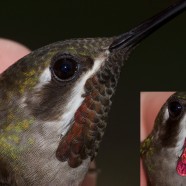Costa Rica: Finca Pura Vida
The last site we do research on is our home base which we call Finca Pura Vida. The Finca is on 10 hectares and backs up to a larger track of contiguous forest. The site has a good variety of different species and is particularly rich with Neotropical migrants. We do the majority of our Hummingbird banding research at the site because it has a healthy migrant population of Ruby-throated Hummingbirds (Archilochus colubris). We band resident hummingbirds as well and have recorded two out of range species. There is a diverse variety of other wildlife and we have noted a great diversity of fauna...
Read MoreLong-billed Starthroat (Heliomaster longirostris) by Sean Graesser
This is a Long-billed Starthroat (Heliomaster longirostris), another out of range species that Sean has been finding on the Nicoya peninsula. What he wanted to highlight here were the gorget feathers. These are the feathers located on the throat of this hummingbird and where males typically have their most colorful plumage. In most hummingbird species males develop these feathers as they age to be used for breeding displays with females. The gorget feathers actually reflect light due to their shape and the colors are not due to keratin based pigmentation. At different angles the light...
Read MoreNovember movements and rarities
The atmosphere of the United States can be very chaotic in November with warm air being drawn up ahead of powerful cold fronts and large sections of the country being influenced by the same system. Often times these currents move birds, already in motion during migration, very far from where they are supposed to be. Across the northeastern part of the country it is known as a time to find extreme rarities. Scissor-tailed Flycatchers (Tyrannus forficatus) typically move from the central U.S. to Central America, but once in a while a bird will go the opposite direction and end up far...
Read More






